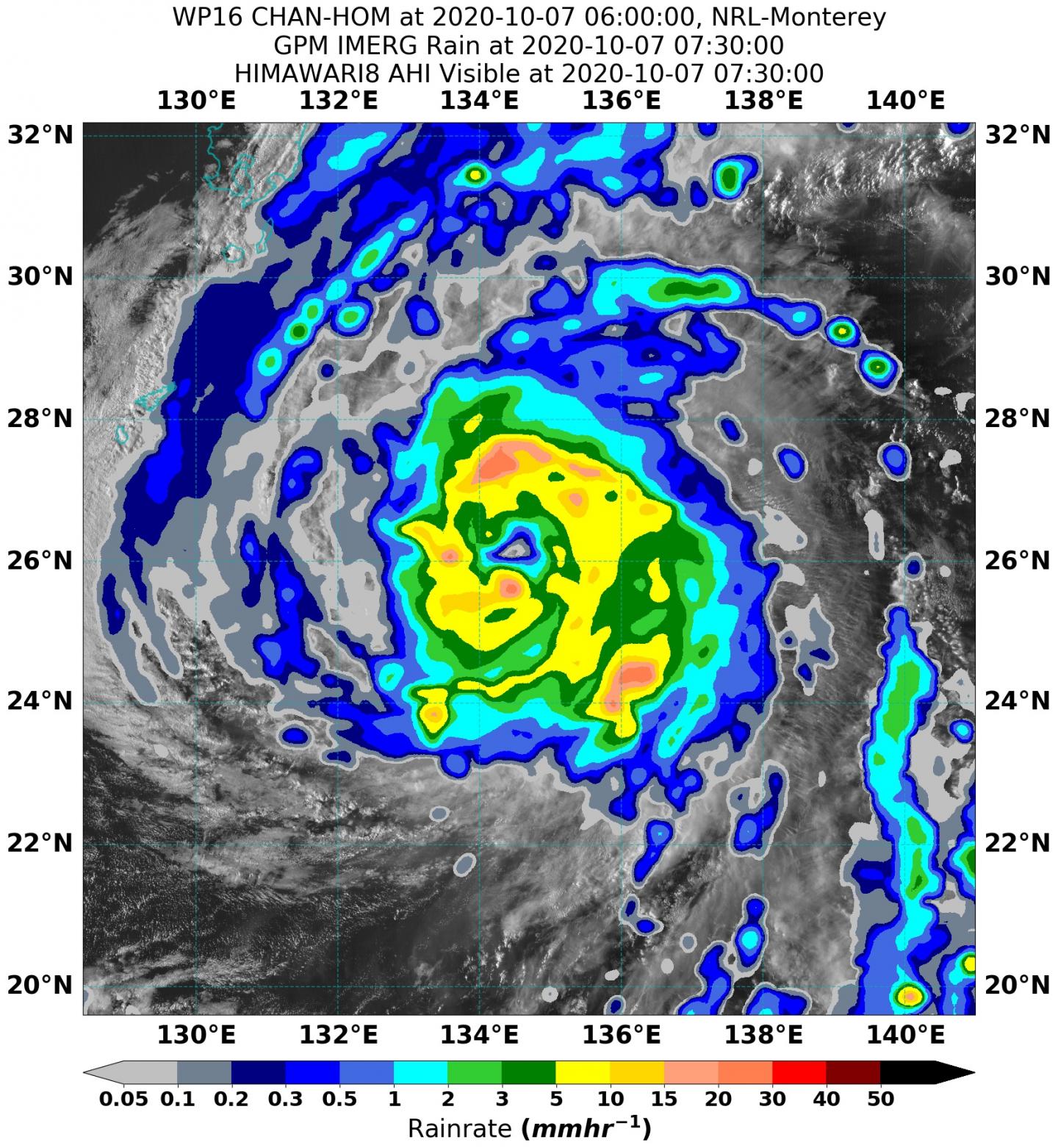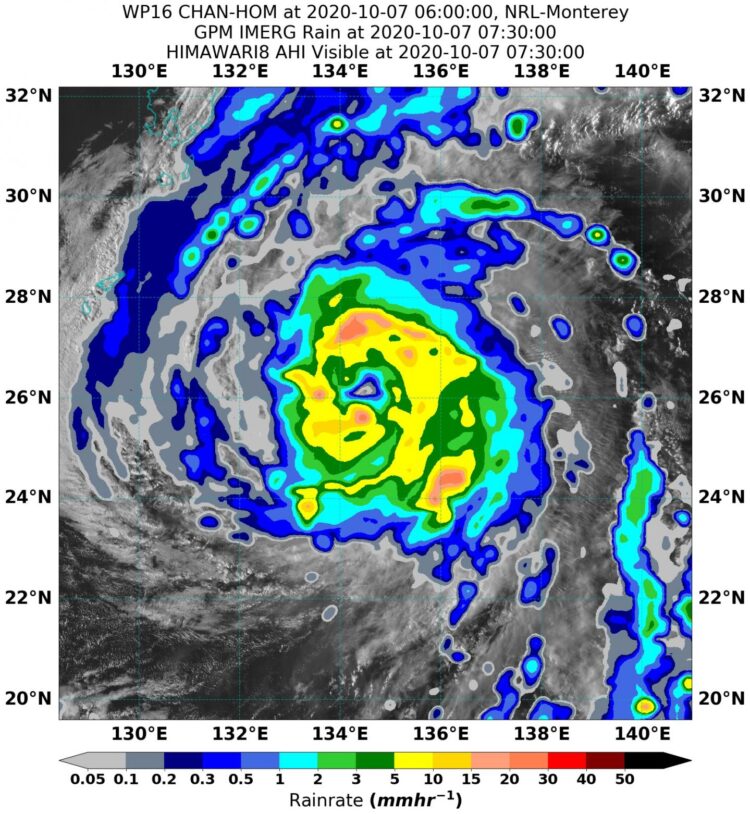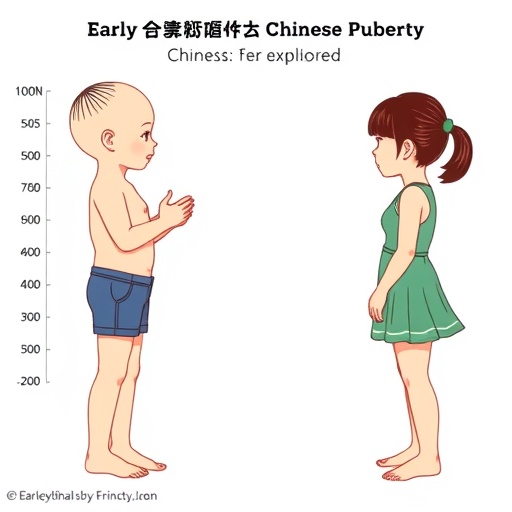
Credit: Credit: NASA/NOAA/NRL
A NASA satellite rainfall product that incorporates data from satellites and observations found heavy rainfall occurring throughout Typhoon Chan-hom and the heaviest rainfall in the eyewall. Chan-hom is expected to bring rainfall to Japan on its track through the Northwestern Pacific Ocean.
Chan-hom’s Status on Sept. 18
At 5 a.m. EDT (0900 UTC), the center of Typhoon Chan-hom was located near latitude 26.2 degrees north and longitude 134.4 degrees east. It was centered 378 nautical miles east of Kadena Air Base, Okinawa Island, Japan, moving toward the northwest. Maximum sustained winds are near 65 knots (75 mph/120 kph) with higher gusts.
Estimating Chan-hom’s Rainfall Rates from Space
NASA’s Integrated Multi-satellitE Retrievals for GPM or IMERG, which is a NASA satellite rainfall product, estimated on Oct. 7 at 2 a.m. EDT (0600 UTC), Chan-hom was generating as much as 30 mm (1.18 inches) of rain per hour falling in the ragged eyewall that surrounds the eye. Rainfall throughout most of the storm was estimated as falling at a rate between 5 and 15 mm (0.2 to 0.6 inches) per hour. At the U.S. Naval Laboratory in Washington, D.C., the IMERG rainfall data was overlaid on infrared imagery from NOAA’s GOES-16 satellite to provide a full extent of the storm.
In addition to the rainfall calculation within the typhoon, animated enhanced infrared satellite imagery revealed a consolidating system with a ragged eye. Microwave imagery indicates improved banding of thunderstorms wrapping tightly into a microwave eye feature.
Warnings for heavy rainfall are in effect for Kyushu, the southernmost big island of Japan. Watches were posted for much of Japan’s southeastern and east central coasts.
What Does IMERG Do?
This near-real time rainfall estimate comes from the NASA’s IMERG, which combines observations from a fleet of satellites, in near-real time, to provide near-global estimates of precipitation every 30 minutes. By combining NASA precipitation estimates with other data sources, we can gain a greater understanding of major storms that affect our planet.
Instead, what the IMERG does is “morph” high-quality satellite observations along the direction of the steering winds to deliver information about rain at times and places where such satellite overflights did not occur. Information morphing is particularly important over the majority of the world’s surface that lacks ground-radar coverage. Basically, IMERG fills in the blanks between weather observation stations.
Chan-hom’s Forecast
Forecasters at the Joint Typhoon Warning Center (JTWC) expect Chan-hom to track northwestward to northward through the next two days and closer to Japan. Chan-hom is forecast to make a slow track paralleling the coast of Japan from Oct. 8 through the 11, when it is expected to affect Tokyo before heading out to open waters.
JTWC expects Chan-hom to continue weakening over the next several days and begin transitioning to an extra-tropical storm.
NASA Researches Tropical Cyclones
Hurricanes/tropical cyclones are the most powerful weather events on Earth. NASA’s expertise in space and scientific exploration contributes to essential services provided to the American people by other federal agencies, such as hurricane weather forecasting.
For more than five decades, NASA has used the vantage point of space to understand and explore our home planet, improve lives and safeguard our future. NASA brings together technology, science, and unique global Earth observations to provide societal benefits and strengthen our nation. Advancing knowledge of our home planet contributes directly to America’s leadership in space and scientific exploration.
For more information about NASA’s IMERG, visit: https:/
For updated warnings from the Japan Meteorological Agency, visit: https:/
By Rob Gutro
NASA’s Goddard Space Flight Center
###
Media Contact
Rob Gutro
[email protected]
Original Source
https:/





